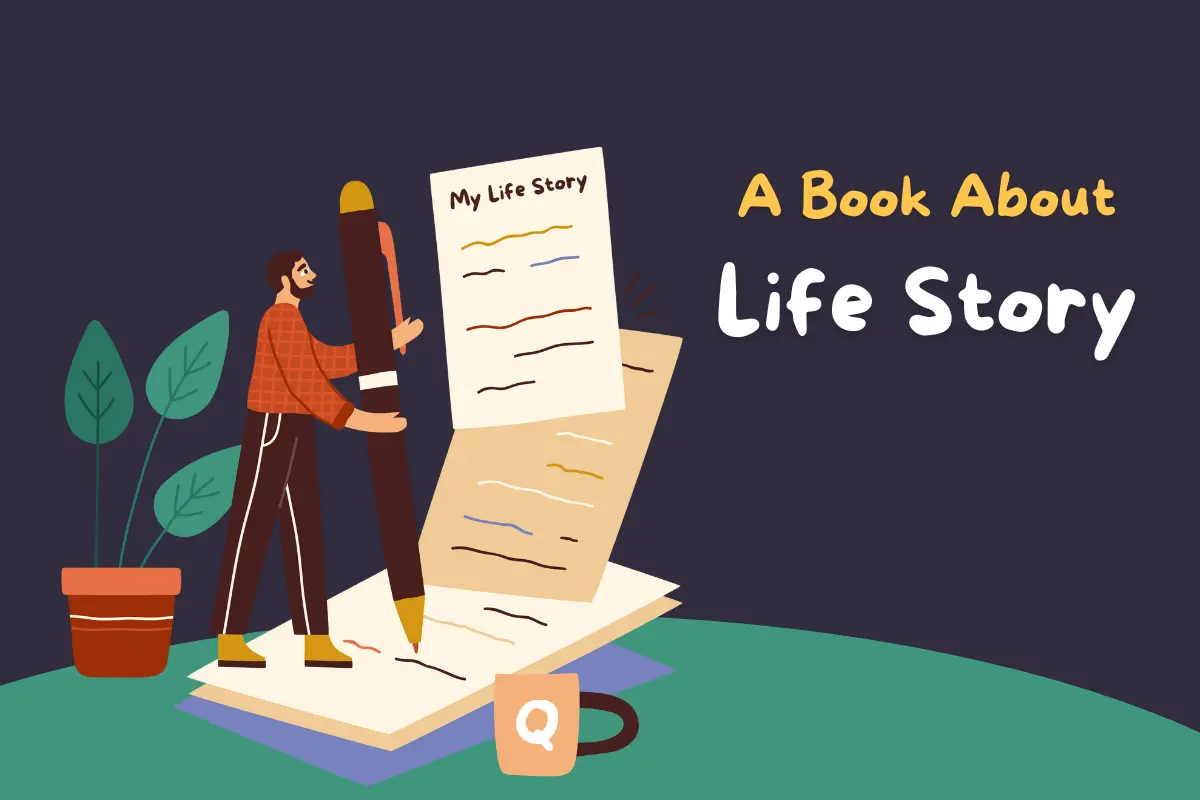How to Write a Book Like a Pro in 2024
Start your writing adventure today and unlock your creative potential as you discover how to write a book from scratch!

Rijvi Ahmed
Last updated on Jul 4th, 2024

When you click on affiliate links on QuillMuse.com and make a purchase, you won’t pay a penny more, but we’ll get a small commission—this helps us keep up with publishing valuable content on QuillMuse. Read More.
Table of Contents
Deciding to start writing a book can be intimidating, especially if you’re a beginner. It can paralyze you When you’re unsure where to begin writing a book.
Starting and finishing a book requires grit, but we believe that with the right tips and tools, anyone can do it. You have fantastic book ideas to share with the world, and your book, regardless of genre, has the potential to change someone’s life. But, how to write a book?
Writing a book can be a huge step forward for established writers or an opportunity to showcase a new writer’s abilities. Books can require extensive research, planning, and organization, and some genres have very specific formatting and story structure requirements.
In this article, I will explain how to write a book in 8 steps and provide some useful tips on how to write a book to help you improve the efficiency of your writing process.
How to Write a Book for Beginners (Video)
How to Write a Book With 8 Steps
Writing a book is a tough yet rewarding effort that many people aspire to. Whether you have a burning narrative inside you or a message you want to share with the world, writing a book is an exciting and rewarding experience. Here are 8 steps to take you through this process:

1. Develop a Writer’s Mindset
Your mindset describes how you think about something. So a writing mindset is how you approach writing. We want to cultivate a writer’s/writing mindset that will benefit our creative work and it’s the first step in how to write a book.
The first steps in learning how to write a book are to overcome mindset barriers, deal with writer self-doubt, and cultivate a positive mindset that will help you achieve your writing goals.
The building blocks required to help us think about our writing productively and creatively. This includes:
- Setting a clear writing routine. Knowing when you have in mind to write and regularly scheduling your week to allow for writing time.
- Set targets and goals for your job. This allows us to move projects forward rather than waiting to be motivated or inspired. When we have targets and goals, our mindset becomes more focused.
- Make a space for you to finish your work. Some people believe that sitting at a specific desk puts them in the right mindset to write instead of sitting on the sofa.
- Make time for your writing. Some people advise you to treat your writing as a job and show up regularly; this may work for you, depending on your circumstances.
These basics are good, and they can help us with our writing; however, when we consider our writing mindset and how it influences how we approach our work, having a good writing routine and planning out when we will write isn’t always enough.
We need more tools to deal with difficult situations. In our Developing a Writing Mindset workbook, we go over some of the ways you can maintain and continually develop a writing mindset that will benefit you in the long run.

2. Choose a Comfortable Space to Write Your Book
The second step in writing a book is to consider your environment. Where you choose to write has a significant impact on your writing productivity. Find creative spaces where you can do your best writing.
Everyone has their preferences when it comes to writing spaces. Some may prefer a quiet, clean environment away from distractions, while others may thrive in a bustling coffee shop with their laptop and headphones.
The key is to find a space that meets your needs and allows you to develop a productive writing routine. To improve concentration and efficiency, you must first find a suitable physical environment and writing platform.
First, find a space where you can write regularly. Although you can write whenever and wherever you want, having a consistent writing space is beneficial if you want to establish a writing routine.
Look around your house. What space do you have open for your writing? If you have a spare room that is rarely used, this could be the perfect location. Perhaps you have a potential living room corner or a kitchen breakfast nook. Even if your kitchen table is the best option available at home, that’s fine! You can make it work.

3. Choose your Book Writing Software and Tools
The next step in writing a book involves using writing tools. Nowadays, we’ve got computers with word processing capabilities and the internet, where you can find an endless array of useful book writing software and apps designed to help you be an efficient and effective writer.
Choosing the right book writing software and tools can significantly improve your writing process and productivity. Here are some popular and best writing websites to think about:
1. Scrivener: It has powerful features for organizing, outlining, and formatting your manuscript. It’s especially useful for organizing complex projects, storing research materials, and navigating between sections of a manuscript.
2. Microsoft Word: Word is widely used and well known for its powerful word processing capabilities, which include writing, formatting, and editing your book. Its extensive features make it suitable for both new and experienced writers, providing flexibility in document creation and management.
3. Google Docs: With its cloud-based platform, allows for real-time collaboration and accessibility across devices. It’s ideal for writers who need to collaborate with editors or coauthors, as it includes features such as commenting, editing suggestions, and seamless document sharing.
4. Notion: It’s an all-in-one workspace that allows writers to create custom workflows that are tailored to their specific needs. Whether you’re outlining your book, tracking progress, or collaborating with others, Notion offers a customizable platform for managing all aspects of your book effectively.
5. Grammarly: It’s a writing assistant, that helps you improve your writing by highlighting grammar, punctuation, and spelling errors. Its user-friendly interface and real-time feedback make it an excellent tool for improving your manuscript and readability.
6. QuillMuse: It’s a platform that helps you grow by providing a library of writing tips, tutorials, prompts, and challenges to inspire and challenge you. QuillMuse has something for everyone, whether they write fiction, nonfiction, poetry, or something in between. You will find informative and inspiring articles on a variety of writing-related topics, including how to overcome writer’s block, how to write a book, edit your work, and more.
When deciding on the best software and tools for your bookwriting journey, keep your writing style, workflow preferences, and project requirements in mind. Each option provides unique features and benefits to help you bring your story to life.

4. Final Your Book Topic
Now we’ll talk about how to start writing a book. This is the part that appears simple but may be more difficult than you realize. However, once you’ve completed the process of writing your book, you’ll be motivated to finish it and publish it.
The first step is to decide on a topic for your book. Choosing a topic for a new book can be both exciting and daunting. Here are the steps to guide you through the process:
1. Discover Your Passions: Begin by brainstorming topics that pique your interest, whether they relate to your hobbies, experiences, or areas of expertise.
2. Understand Your Audience: Think about the demographics, interests, and needs of your potential readers. Your topic should appeal to them and provide value.
3. Research Market Trends: Find out what topics are currently popular or in demand. Check bestseller lists, browse bookstores, and look into online communities to identify potential gaps or opportunities.
4. Assess Your Expertise: Evaluate your knowledge and experience with potential topics. Choose a topic where you can provide unique insights or expertise, allowing you to write authoritatively on the subject.
5. Refine Your Ideas: Narrow down your list of topics based on feasibility, relevance, and your connection to the subject. Consider the scope of each topic and whether it is appropriate for a book length treatment.
6. Find Your Unique Angle: Determine what distinguishes your book from others on the same topic. Consider how you can provide a new perspective, unique insights, or a novel approach to help your book stand out in the market.
7. Consider Personal Significance: Think about what the topic means to you personally. Writing a book requires a significant investment of time and energy, so choose a topic that speaks to you on a personal level and is consistent with your values and goals.

5. Write The Book Outline
An outline provides a clear direction and purpose for your work. It acts as a guiding light, directing you toward the ultimate aim of writing a cohesive and captivating work.
While an outline gives structure, it also promotes flexibility and creativity. It is not set in stone and can be changed as you progress through your work and new ideas emerge. It helps you stay focused and guarantees that your book flows logically from beginning to end.
Outlining your book beforehand lets you be clear about what you want to say and how you want to convey it. It helps you uncover gaps in your tale or arguments early on, allowing you to resolve them before beginning the writing process.
A clear outline simplifies the review and editing process. You may easily find parts that need improvement or restructuring and make the necessary changes without completely reworking the manuscript.
A book outline is essentially the author’s hidden weapon. It prepares you to face the enormous process of writing a book with confidence, clarity, and efficiency. So, the next time you start writing, don’t underestimate the value of a well crafted outline—it could be the key to your success.

6. Finish Writing Your Book Draft
Use your outline to create your first draft. Don’t stress about whether it’s flawless or if you’ve included all you need.
As you develop a writing habit, you will be inspired by ideas that you may wish to incorporate into an earlier or later stage of your novel. That is the purpose of a first draft: to allow your book to be a living, thinking, evolving document.
Use your own writing voice for your novel. Do not strive to write like other authors, but you can benefit from their good writing habits. However, make sure your first draft reflects who you are and what you want to say. It’s unlikely that this will be your only book. You’ll want your voice to come through and be known to your readers.
When you believe you have written the tale you want to tell in your first draft, you will concentrate on editing and revising.

7. Edit Your Book
When you get into your writing pattern and start typing a new page or chapter, it should come as a continuous flow of consciousness.
Don’t worry about how good it sounds or how many faults there are; just write. Write rapidly until the page, chapter, or part you’re working on is finished. This is also a successful way to overcome writer’s block.
Later, you can go back and thoroughly edit your work, removing unneeded content, refining your writing, and removing writing errors. However, the most crucial thing to do at first is to get your thoughts on paper in the form of a rough draft.
It is usually best to evaluate your work yourself first to verify that you have addressed all of your desired concepts. If you continue to self-edit, use one or more of the various writing tools available to you. These will assist you with identifying spelling, grammatical, and technical issues, as well as providing advice on voice and tone.
If you want to selfedit I will recommend Quillmuse. Quillmuse helps you grow by providing a library of writing tips, tutorials, prompts, and challenges to inspire and challenge you. Use Grammerly for editing. You can also employ a professional editor to ensure that your book is polished from cover to cover. This is especially beneficial if you’re self-publishing.

8. Publish Your Book for Readers to Buy
The steps in the self-publishing process vary depending on whether you intend to publish your book as an eBook or in print.
It will also vary based on the self-publishing businesses you intend to engage with. There are other self-publishing options to select from, including KDP on Amazon and Ingram Spark.
If you intend to deal with a different book publisher, you should follow their criteria. You should also learn how to copyright a book so that you can avoid plagiarism.
Once you’ve pushed publish on your platform, you can begin implementing your launch and promotion tactics.
What If You Have No Experience
Writing a book can be a daunting task, especially if you have no previous experience. However, a lack of experience should not deter you from pursuing your objective if you have a story or information to share. So, how to write a book without experience?
Even if you have no prior experience on how to write a book, you will need some advice to get started on writing your book. So, we already have a piece titled “How to Write a Book with No Experience”.
Writing a book may appear to be a daunting endeavor for beginners, but it is fully achievable with the appropriate mindset, strategy, and determination. Accept the road, stick to your passion, and remember that every word you write puts you one step closer to accomplishing your ambition of becoming a published author.
Conclusion
To summarize, writing a book is a joyful and rewarding process that anyone may undertake, regardless of prior experience. You may make your ambition of becoming a published bestselling author a reality by following the steps given in this article, which include discovering your passion and outlining your vision, as well as remaining persistent and seeking feedback.
Remember that writing is a process, and it is acceptable to make mistakes along the way. What matters is that you keep moving forward, stay true to your vision, and never lose sight of your enthusiasm for storytelling.
So, roll up your sleeves, grab a pen (or keyboard), and begin writing your book now. Your tale is waiting to be told, and the world is eager to hear it. Happy writing!
FAQs on How to Write a Book
How do I write a book if I’ve never done it before?
Begin by brainstorming ideas and finding your passions or interests. Then, outline to arrange your ideas and structure your book.
How can I find time to write a book with such a busy schedule?
Make writing a priority by scheduling it every day or week. Even modest amounts of time might pile up and affect your development.
How can I keep motivated during the writing process?
Draw inspiration from other authors, set attainable goals, and remind yourself why you wanted to create a book in the first place. Celebrate milestones along the road to maintain your motivation.
How do I know when my book is ready for publication?
Once you’ve written numerous drafts, updated and edited your work, and received input from beta readers or editors, you’ll be closer to publishing your book. Trust your intuition, but also be open to constructive feedback that will help you better your work.
How can I sell and promote my book once it is published?
Create a marketing strategy that includes developing an online presence, engaging with your target audience via social media and author events, and using book reviews and endorsements to generate discussion about your book.
How we've reviewed this article
Our content is thoroughly researched and fact-checked using reputable sources. While we aim for precision, we encourage independent verification for complete confidence.
We keep our articles up-to-date regularly to ensure accuracy and relevance as new information becomes available.
- Current Version
- Jul 4th, 2024
- Feb 24th, 2024


